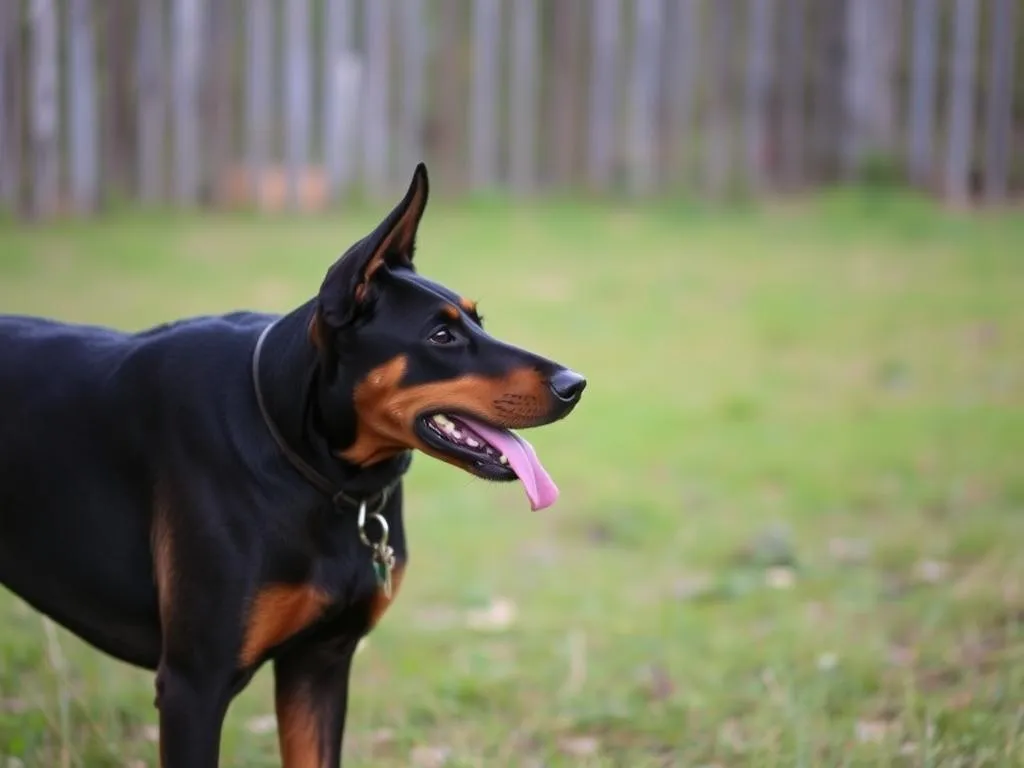
Introduction
Doberman Pinschers are renowned for their loyalty, intelligence, and protective instincts, making them one of the best breeds for guard dog training. With a muscular build and agile nature, Dobermans can stand their ground and effectively protect their families. However, training is crucial to harness these traits effectively. The right training can transform a loving pet into a reliable guard dog, capable of distinguishing between friend and foe. This guide will help you understand how to train your Doberman to be a guard dog, focusing on the essential techniques and considerations for successful training.
Understanding the Doberman Breed
Physical Characteristics
Dobermans typically stand between 24 to 28 inches tall and weigh between 60 to 100 pounds. Their sleek, muscular bodies provide them with both strength and speed, which are essential for a guard dog. Their powerful jaws and sharp senses make them natural protectors, able to react quickly to potential threats.
Temperament
What sets Dobermans apart is their unique combination of intelligence, loyalty, and a strong protective instinct. They are highly trainable and eager to please their owners. This breed is often characterized by its alertness, making them ideal for guarding roles. However, they require firm, consistent training to channel their protective nature positively.
Common Misconceptions
Despite their reputation, many misconceptions exist around the Doberman breed, notably the idea that they are inherently aggressive or dangerous. In reality, a well-trained Doberman is a loving and loyal companion. It is essential to understand that aggression is a result of improper training or neglect rather than an inherent trait of the breed.
The Basics of Dog Training
Principles of Dog Training
When training a Doberman (or any dog), the principles of positive reinforcement play a vital role. This method encourages desired behaviors by rewarding the dog, while negative reinforcement can often lead to fear or anxiety. Consistency in commands and routines is also essential, as it helps your Doberman understand what is expected of them.
Key Commands Every Guard Dog Should Know
To effectively train a Doberman as a guard dog, they must master basic commands. Key commands include:
- Sit
- Stay
- Come
- Heel
- Leave it
These commands form the foundation of more advanced training and help ensure your Doberman can respond promptly to your instructions.
Importance of Socialization
Socialization is critical for Dobermans, especially in guarding roles. Introducing your Doberman to various environments, people, and other animals helps them learn appropriate responses to different situations. A well-socialized Doberman is less likely to react aggressively out of fear or uncertainty, making them more reliable as guard dogs.
Preparing for Guard Dog Training
Assessing Your Doberman’s Temperament
Before beginning training, assess your Doberman’s temperament. Look for signs of natural protective instincts, such as alertness to unfamiliar noises or people. Understanding your dog’s personality will help tailor the training approach to suit their unique characteristics.
Essential Equipment
Having the right equipment is crucial for effective training. Essential items include:
- Leash: A sturdy leash helps maintain control during training sessions.
- Collar: Choose a collar that fits well and is comfortable for your Doberman.
- Training Aids: Consider using a clicker for positive reinforcement and other training aids, like toys or treats.
Setting Up a Training Environment
Create a safe and distraction-free training environment, both indoors and outdoors. Ensure the area is secure, allowing your Doberman to focus on training without interruptions. A familiar setting will help your dog feel more at ease during training sessions.
Step-by-Step Training Guide
Basic Obedience Training
Begin with basic obedience commands to establish a solid foundation. Use positive reinforcement techniques, such as treats or praise, to encourage compliance. For example, when your Doberman sits upon command, reward them immediately. This approach reinforces good behavior and establishes trust between you and your dog.
Introducing Guard Dog Behaviors
Once your Doberman has mastered basic commands, gradually introduce guard dog behaviors.
- Teaching Barking on Command: Use a specific command or cue to teach your dog to bark on command. This can be useful in alerting you to potential threats.
- Encouraging Alertness to Strangers: Expose your Doberman to various people in controlled settings. Reward them for remaining calm and alert, reinforcing the idea that they should be attentive to unfamiliar individuals.
Controlled Aggression Training
Introducing controlled aggression training is essential for a guard dog. This does not mean instilling fear or aggression but rather teaching your Doberman to respond appropriately in protective situations.
- Using a Bite Sleeve or Toy: Introduce a bite sleeve or toy during training to teach your dog how to respond to threats safely. Start by encouraging them to bite or hold the sleeve gently, rewarding them for appropriate behavior.
Advanced Guard Dog Training Techniques
Scenario-Based Training
Simulating real-life situations is crucial for advanced guard dog training. Practice scenarios such as a stranger approaching your home or a simulated home invasion. This helps your Doberman learn how to react appropriately in various situations.
Building Confidence and Independence
Encourage your Doberman to make decisions during training scenarios. This fosters independence and confidence, essential traits for a guard dog. Allow them to assess situations and respond accordingly, reinforcing their role as a protector.
Handling Distractions
Train your Doberman in environments with various distractions, such as loud noises, other animals, and people. This exposure helps them learn to maintain focus, even in challenging situations. Reward them for staying calm and attentive amidst distractions.
Maintaining Your Doberman’s Guard Dog Skills
Regular Training Sessions
Consistency is key in maintaining your Doberman’s guard dog skills. Schedule regular training sessions to reinforce commands and behaviors. Short, frequent training sessions are often more effective than long, infrequent ones.
Physical and Mental Stimulation
Keeping your Doberman physically and mentally stimulated is essential for their overall well-being. Engage in activities such as agility training, obedience exercises, and playtime. This not only keeps them fit but also sharpens their guarding instincts.
Signs of Stress or Burnout
Be attentive to signs of stress or burnout in your Doberman. If they seem disinterested or overwhelmed during training, it may be time to take a break or modify your approach. Ensuring your dog enjoys the training process is vital for their long-term success as a guard dog.
Safety Considerations
Understanding Your Doberman’s Limits
Recognizing your Doberman’s limits is crucial in training. Avoid overtraining or pushing them beyond their comfort zone, as this can lead to stress or fear. A well-adjusted, confident dog is far more effective as a guard dog.
Legal and Ethical Responsibilities
As a Doberman owner, be aware of the legal and ethical responsibilities associated with having a guard dog. Familiarize yourself with local laws regarding guard dogs and ensure your training methods promote a balanced, well-behaved dog.
Troubleshooting Common Training Issues
Dealing with Fearfulness
If your Doberman shows signs of fearfulness, it’s essential to build their confidence gradually. Use positive reinforcement to reward brave behavior and avoid exposing them to overwhelming situations too quickly.
Addressing Aggression Towards Other Dogs
If your Doberman exhibits aggression towards other dogs, it’s important to address this behavior through training. Use controlled exposure to other dogs and reward calm behavior. Consider consulting a professional trainer if needed.
Inconsistent Behavior
If your Doberman displays inconsistent behavior, identify potential causes. Inconsistency can arise from changes in routine, environment, or stress. Revisit your training approach and ensure you are consistent in commands and rewards.
Conclusion
Training your Doberman to be a guard dog is a rewarding journey that requires patience, commitment, and understanding. By leveraging their natural instincts and combining them with consistent training techniques, you can cultivate a loyal protector for your home. Remember, the key to success lies in patience and the bond you share with your dog. Share your experiences, questions, or tips in the comments to connect with other Doberman enthusiasts!









